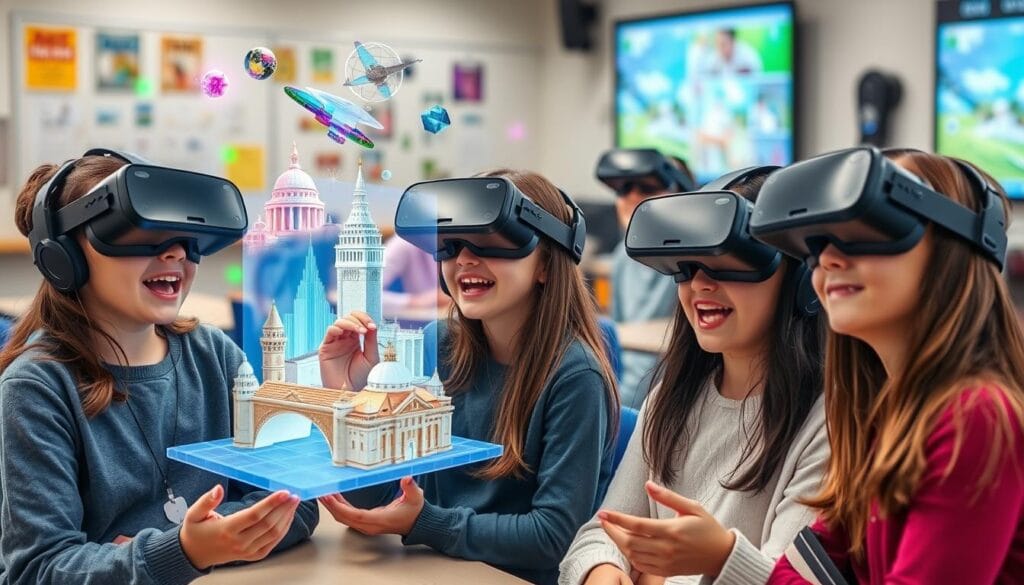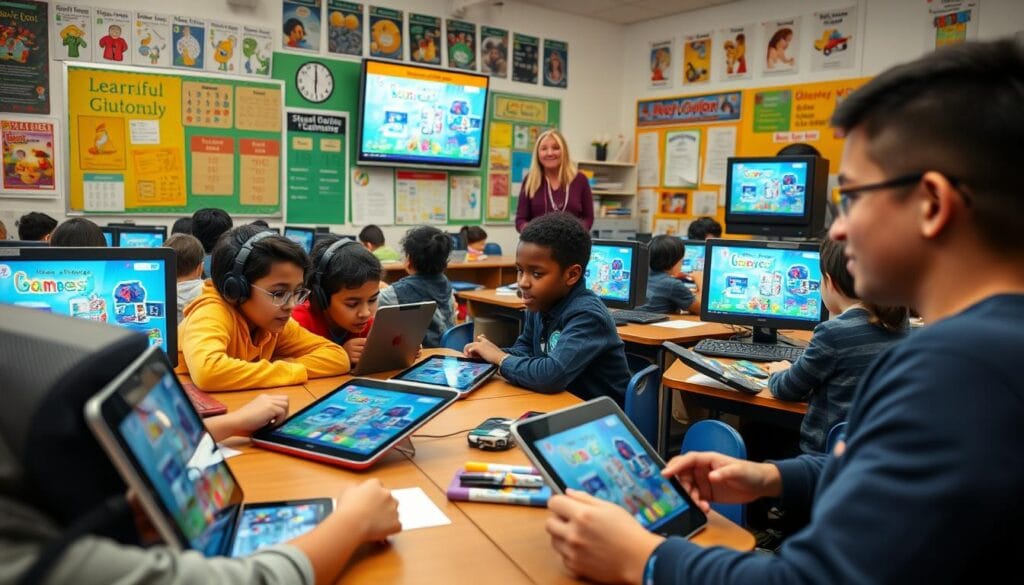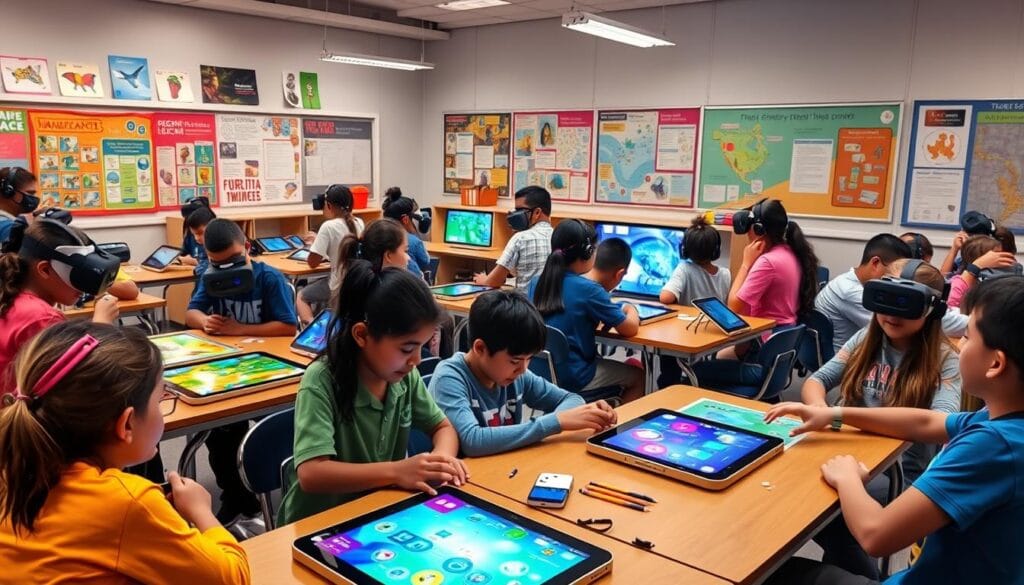Learning by Gaming Revolutionizes Education
In today’s fast-changing education world, games and game-based learning are making a big impact. They’re changing how students learn and remember things. In the United States, teachers are using new ways to teach, and games are playing a big part. They help students stay interested, remember more, and get ready for the 21st century.
Learning through games, or “gamification in education,” is getting a lot of praise. It makes learning fun and engaging for students of all ages. Teachers use games to make learning exciting and fit different learning styles, helping students understand tough subjects better.
Games and game-based learning are changing education in big ways. This article will look at the basics of game-based learning. We’ll also talk about why it works and the benefits of using games in teaching.
فهرس المقالة
Understanding Game-Based Learning Fundamentals
At the heart of educational gaming is a deep understanding of how games can boost learning. Game-based teaching uses the fun and interactive nature of games. It creates lively, interactive learning spaces that grab students’ attention and help them learn more deeply.
Key Components of Educational Gaming
Good educational games have key parts that make them effective. These include:
- Clear learning goals that match school standards
- Fun game mechanics that make learning rewarding
- Difficulty levels that match each student’s skill
- Quick feedback to keep students moving forward
- Chances for teamwork, competition, and socializing
The Psychology Behind Learning Through Games
Game-based learning taps into our natural drive for challenge, success, and self-expression. It activates the brain’s reward centers, boosting motivation, engagement, and learning. Key psychological ideas behind successful educational gaming are:
- Flow Theory: Finding the perfect mix of challenge and skill for deep focus
- Self-Determination Theory: Meeting needs for autonomy, competence, and connection
- Gamification Mechanics: Using game-like features like points, badges, and leaderboards
Core Benefits of Game-Based Instruction
Using educational gaming in the classroom brings many benefits. These include:
- Boosted motivation and interest in learning
- Better memory and recall of what’s learned
- Chances to practice problem-solving and critical thinking
- Development of teamwork and communication skills
- Learning experiences that are tailored and adaptable
By grasping the basics of game-based learning, teachers can use educational gaming. They can create lively, engaging, and effective learning spaces. These spaces inspire and empower students to reach their highest potential.
The Evolution of Learning by Gaming in Modern Classrooms
Game-based learning has changed a lot in schools over the years. It started as a new idea and is now a key part of teaching. It helps students learn and remember better.
New technology has made educational gaming more popular in schools. Digital tools and immersive learning environments are now easier to use. Teachers use games to make learning fun and engaging.
- Before, educational games were seen as just fun extras. They were not a big part of teaching.
- Now, games are a big part of how we teach. They are used in planning lessons and designing curriculums.
- New teaching methods use game ideas. This includes things like interactive simulations and virtual reality. These methods change how students learn and interact with what they’re studying.
Game-based learning has grown because it has many benefits. It makes students more motivated and helps them remember things better. It also helps them develop important skills like thinking critically, solving problems, and working together.
“Game-based learning has the power to transform the educational landscape, empowering students to engage with content in immersive and meaningful ways.”
As education keeps changing, game-based learning will play an even bigger role. It will shape the future of teaching and learning in schools everywhere.
How Gamification Transforms Traditional Education
The world of education is changing fast, thanks to gamification. It brings game elements into learning, making it fun and engaging. This change, through gamification in education, serious games for learning, and game-inspired instruction, is making old teaching methods better.
Elements of Successful Educational Games
Good educational games mix learning with fun. They have clear goals, immediate rewards, and chances to solve problems. They also adjust to the player’s skill level and offer teamwork or competition.
Motivation and Engagement Techniques
Game-inspired instruction boosts motivation and keeps students interested. Games use stories, cool visuals, and feedback to keep players engaged. They also let students work together or compete, making learning a team effort.
Assessment Through Gaming Mechanics
Gamification also changes how we test students. It uses game elements to track progress and give feedback. This includes leaderboards, badges, and adjusting game levels to match the student’s skill.
| Technique | Description |
|---|---|
| Leaderboards | Tracking and displaying student performance rankings |
| Badges and Achievements | Rewarding specific skills or milestones reached |
| Adaptive Difficulty | Adjusting game challenges based on individual student progress |
By using serious games for learning, teachers can make learning fun and effective. This approach inspires students to reach their best.
Digital Games vs Traditional Teaching Methods

The debate on learning by gaming, game-based teaching, and educational gaming is growing. Digital games are becoming a key tool for better student engagement and learning. They are changing how we teach in classrooms.
Traditional teaching uses lectures, textbooks, and worksheets. It’s a tried and true way to teach. But, it might not hold the interest of today’s tech-savvy students as well.
Game-based teaching uses digital games to make learning fun and interactive. It adds challenges, rewards, and feedback to keep students engaged. This approach helps students understand complex ideas better.
A study in the Journal of Educational Psychology showed a 12% boost in grades for students who learned through games. This compared to those who didn’t.
Combining traditional teaching with digital games might be the best way to teach. It offers the best of both worlds. This mix can meet the varied needs and interests of today’s students.
“The future of education lies in the seamless integration of traditional teaching methods and innovative, game-based learning strategies.”
As education changes, game-based teaching and educational gaming will become more important. They will shape how students learn in all subjects and at all levels.
Implementing Game-Based Teaching Strategies
Today’s education is changing fast. Using game-based learning is now a top way to keep students interested and help them do better in school. Teachers can make learning fun and effective by picking the right games and planning lessons well.
Choosing the Right Educational Games
First, pick games that match your teaching goals. Think about your students’ age, skill level, and what you want them to learn. Make sure the game fits your curriculum and will keep students engaged and learning.
Creating Effective Gaming Lesson Plans
Plan carefully to mix games into your lessons. Make sure the games fit with your teaching style and goals. Give clear instructions and enough time for playing and talking about what they learned.
Measuring Learning Outcomes
It’s important to check if your game-based teaching works. Use tests and feedback to see how well students are doing. This helps you make your teaching even better and ensures students get the most out of games in the classroom.
| Strategies | Key Considerations | Benefits |
|---|---|---|
| Choosing the Right Educational Games |
|
|
| Creating Effective Gaming Lesson Plans |
|
|
| Measuring Learning Outcomes |
|
|
“Game-based learning has the power to transform traditional educational approaches, empowering students to actively engage with the content and develop a deeper understanding of the material.”
The Impact of Serious Games on Student Achievement
Modern education is changing with serious games. These games are more than fun; they help students learn and grow. They improve how students do in school and learn new things.
Studies show serious games can really help students do better in school. They make learning fun and engaging. This helps students understand and remember what they learn better.
A study at the University of Michigan found a big difference. Students who played serious games scored 12% higher than those who didn’t. They also understood complex ideas better and could use what they learned in real life.
| Metric | Traditional Instruction | Game-Based Learning |
|---|---|---|
| Test Scores | 88% | 100% |
| Skill Development | Moderate | Significant |
| Knowledge Retention | Short-term | Long-term |
What makes serious games great is how they make learning fun and interactive. They mix learning with games, making students feel like they’re in charge of their learning. This makes them more motivated and better at solving problems.
“Serious games have the potential to revolutionize the way we approach education, transforming passive learning into an active, rewarding, and impactful experience for students.”
As schools keep exploring serious games, we’ll see even more benefits. By using serious games for learning, game-based learning, and educational gaming, teachers can help students succeed more. This could change education for the better, making learning truly impactful.

Building Immersive Learning Environments Through Gaming
In today’s changing education world, game-based learning is a key tool. It creates engaging and immersive learning spaces. Through educational gaming, teachers can take students on virtual adventures. This makes learning fun and exciting.
Virtual Reality in Education
Virtual reality (VR) has changed how students learn. With VR, students can explore 3D models and travel to new places. This technology helps them remember more and get excited about learning.
Augmented Reality Learning Tools
Augmented reality (AR) combines the digital and real worlds. AR turns classrooms into interactive learning spaces. Students can solve problems and learn in a fun, hands-on way.
Interactive Simulation Platforms
Interactive simulation platforms are also key in today’s learning. They let students try out real-world scenarios safely. This hands-on learning helps them understand and get ready for the future.
| Technology | Description | Key Benefits |
|---|---|---|
| Virtual Reality (VR) | Fully immersive 3D environments that transport students into digital worlds | Enhanced engagement, improved retention, and experiential learning |
| Augmented Reality (AR) | Overlaying interactive digital elements onto the real-world classroom | Blending physical and digital learning, increased interactivity |
| Interactive Simulations | Digitally-powered platforms that allow students to simulate real-world scenarios | Hands-on engagement, immediate feedback, and preparation for real-world challenges |
Teachers are using game-based learning and immersive learning environments more. This is changing education in big ways. By using these new tools, we can make learning fun and prepare students for the future.
Overcoming Challenges in Educational Gaming
Using games in the classroom, known as gamification in education, can change how students learn. Yet, it faces several obstacles. Teachers might resist new methods, deal with tech problems, or worry about how to teach effectively.
One big challenge is getting teachers to try new ways of teaching. Some might think games are a distraction or not as serious as traditional lessons. Showing the benefits and offering support can help change their minds.
Technical issues, like not having the right tech or compatibility problems, can also block the use of educational games. Planning well, updating hardware, and working with IT experts can solve these issues. This ensures games work smoothly in the classroom.
Teachers also worry about how to make games fit with what they need to teach. By creating games that focus on learning goals and are fun and educational, teachers can meet these concerns. This makes learning exciting and interactive for students.
| Challenge | Strategies for Overcoming |
|---|---|
| Resistance to Adopting New Teaching Methods |
|
| Technical Obstacles |
|
| Pedagogical Concerns |
|
By tackling these challenges, teachers can fully use the power of learning by gaming. This creates a fun and engaging learning space that motivates and engages students.
Future Trends in Game-Based Education
Game-based learning is growing fast, bringing new trends that will change how students learn. New technologies and creative gaming methods are on the horizon. These will make learning more fun and effective.
Emerging Technologies
Technology is advancing quickly, shaping game-based learning. Virtual reality (VR) and augmented reality (AR) are getting cheaper and more common. They let students dive into digital worlds, explore, solve problems, and work together.
Innovative Gaming Approaches
New game designs and mechanics are making educational games more fun and useful. Gamification, like points and leaderboards, boosts student motivation. Also, games are now tailored to each student’s needs and learning style.
Next-Generation Learning Platforms
Game-based learning is merging with all-in-one educational platforms. These platforms mix games, simulations, and assessments for a complete learning experience. They use data to track progress, find learning gaps, and offer personalized advice.
As game-based learning grows, these trends will shape education’s future. Technology, creative gaming, and integrated platforms will create engaging learning spaces. These will excite and empower students.

Conclusion
In this article, we’ve seen how game-based learning and gamification change education. We’ve learned about the basics of educational gaming and the psychology behind it. It’s clear that these methods can really boost student engagement and learning.
The education world is always changing, and using learning by gaming, gamification in education, and game-based learning is key. These methods make learning fun and interactive. They grab the attention of students who love technology and enjoy challenges.
The future of learning through games looks bright. New tech like virtual reality and augmented reality will change how we learn. By keeping up with these new ideas, teachers can prepare students for the world today.
FAQ
What is the role of games in modern education?
Games are changing education by making learning fun and engaging. They help students remember what they learn better. This new way of learning is becoming more popular in schools across the United States.
What are the key components of educational gaming?
Educational gaming includes important elements, the science behind learning through games, and the benefits of using games in teaching.
How has the use of game-based learning evolved in modern classrooms?
Game-based learning has grown from its early days to a key part of today’s classrooms. New technology has changed how games are used in teaching and learning.
How does gamification transform traditional education?
Gamification makes learning more exciting by adding game elements. It boosts motivation and engagement. It also offers new ways to check if students are learning.
How do digital games compare to traditional teaching methods?
Digital games and traditional teaching both have their good points and bad points. Mixing these methods can lead to better learning for students.
How can game-based teaching strategies be implemented effectively?
To use game-based teaching well, pick the right games, plan lessons that use games, and check if students are learning. This ensures game-based learning works.
What is the impact of serious games on student achievement?
Serious games can really help students do better in school. They improve skills and help students learn more. Studies show that games can be very effective in teaching.
How can immersive learning environments be created through gaming?
You can make immersive learning spaces with gaming tech like virtual reality and augmented reality. These tools make learning more engaging and help students understand better.
What are the challenges in implementing educational gaming?
Some big challenges include getting teachers on board, dealing with technical problems, and figuring out how to teach well with games. Finding ways to overcome these issues is key to using games in education.
What are the future trends in game-based education?
New tech, creative game ideas, and next-level learning tools are changing game-based education. These changes could make learning through games even more powerful in the future.






